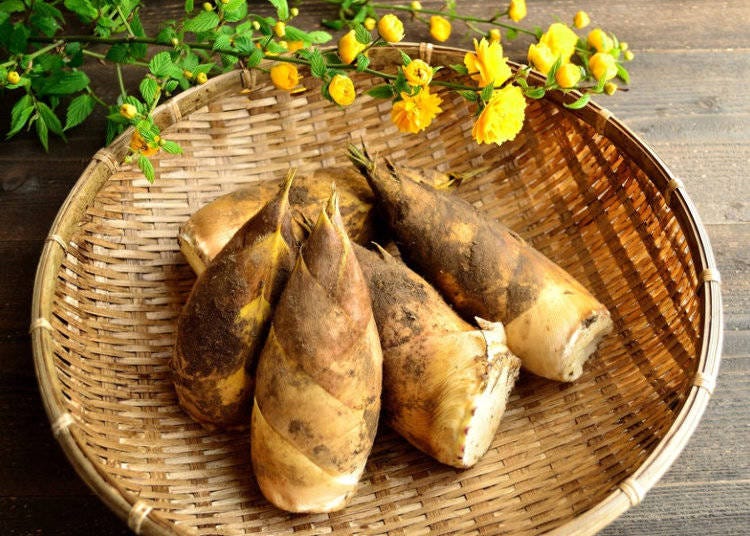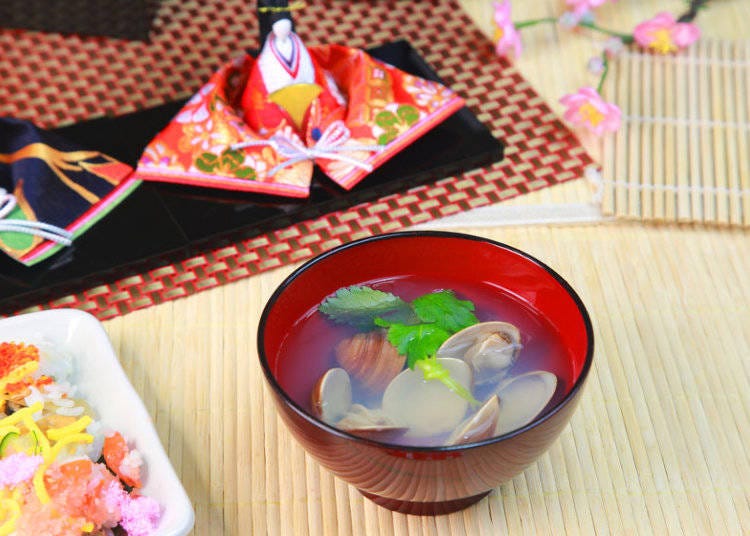
Who doesn’t know that feeling of giddy excitement when the temperatures rise and the winds turn from cold to pleasant? “Ah, spring is here!” is a phrase sighed happily in many parts of the world, but did you know that Japanese people tend to proclaim the changing of the seasons over a delicious plate full of food? Surrounded by oceans and studded with mountains, Japan has a rich variety of all kinds of characteristic, seasonal ingredients to offer. Let’s take a look at what kind of food gets Japanese people in the proper spring fever mood!
The Most Characteristic Spring Vegetable? Bamboo Shoots, of Course!

Between March and April, supermarkets all over Japan are stocked with fresh wild vegetables and mountain herbs such as Fatsia sprouts, fuki buds, rape blossoms, and bamboo shoots. These kinds of wild vegetables are often boiled and also make for excellent tempura. Due to their vivid color, particularly rape blossoms are used for a side-dish called ohitashi, topped with peppers.

The most famous and most commonly eaten spring vegetables are, however, bamboo shoots. Just boil them, season them with soy sauce, and you’re in for spring fever deliciousness! A lot of people also enjoy bamboo shoots simply with some white rice on the side. This is one of the best things about spring vegetables: they’re not only delicious, they go well with all kinds of dishes and are easy to prepare!
Strawberry, the Queen of Japanese Spring Foods

It’s no exaggeration to say that upon hearing “spring food,” strawberries – called ‘ichigo’ in Japanese – are the very first thought of pretty much every Japanese person. Due to targeted growing, there are now a large variety of different strawberry types available; sweet, large, and even white. Once spring is at the nation’s doorstep, the fruit aisles of supermarkets will shine in bright red, filled to the brim with strawberry deliciousness. A favorite spring pastime of Japanese families is strawberry picking, while many a hotel and restaurant hosts strawberry-centered buffets. In spring, strawberry is in the center of many an event and thus probably the Queen of all spring foods.
Clams, Mussels, and Sardines: The Excellent Seafood of Spring

In a country surrounded by various oceans, it comes to no surprise that seafood is enjoyed throughout the entire year in Japan. But even in this category, characteristic spring ingredients can be found on many a menu. The seafood spring is marked by the opening of the catching season for shirasu, young sardines, in mid-March, as well as by the sea bream that lays its eggs in May.
Additionally, clams and mussels are in season and can often be found in miso and clear soups during the months of spring. Along with chirashi-sushi, especially clear soup with mussels is a staple dish on the day of the Girl’s Festival, or hinamatsuri, in March.
Sakura Mochi, the Sweet Food of Spring

There’s hardly a person interested in Japan who hasn’t heard about sakura, the beautiful cherry blossoms, as well as the cherry blossom viewing parties being held all over the country to celebrate spring and refresh one’s mind and body after the long, cold winter. However, fewer people might be familiar with the fact that in Japan’s rich tea culture, sakura has also a significance among seasonal sweets. Among all the cherry blossom sweets, the sakura mochi may be perhaps the most famous of all. Sakura mochi is a pink rice cake, wrapped in the salted leaves of the cherry tree, filled with sweet red bean paste called anko.

Another characteristic sweet of spring is yomogi mochi, or mugwort rice cake, as well as uguisu mochi, which is an anko-filled rice cake topped with green soy flour. Uguisu refers to the Japanese nightingale and the tasty spring food is said to be fashioned after the green feathers of this bird, as it sings beautifully in spring.
*Prices and options mentioned are subject to change.
*Unless stated otherwise, all prices include tax.
Popular Tours & Activitiess
Recommended places for you
-

Nichigekka Ginza
Japanese cuisine
Ginza
-

MINOKICHIHoteruhankyuintanashonaru
Japanese cuisine
Umeda, Osaka Station, Kitashinchi
-

Kurayamizaka Miyashita Marubiru
Japanese cuisine
Tokyo Station
-

Hanamicyou
Japanese cuisine
Harajuku
-
Menu

Ganso Kamameshi Haru
Japanese cuisine
Asakusa
-

Oto-Oto Ikebukuro
Japanese cuisine
Ikebukuro
-

Shizuoka Road Trip: Explore the Home of Mt. Fuji with a 3-Day Rental Car Itinerary
-

Best Things to Do and See Around Tokyo in September: Events and Festivals in Kanto
-

Half-Day Getaway from Tokyo: Cherry Blossoms, Local Culture and Samurai Vibes at Odawara Castle
-

[Shinjuku] 10 Hotels Balancing Cost Performance and Comfort | Perfect for Both Business and Tourism!
by: Flurina YOC
-

Autumn in Japan 2025: Fall Foliage Forecast & Where to Enjoy the Colorful Leaves (+Tour Info)
-

Where to Buy Electronics in Ikebukuro: 6 Tax-Free Shops for Tourists in Tokyo
by: Ran Tanaka
-

Visiting Tsutenkaku Tower: Osaka's Retro Icon in the Heart of Shinsekai
by: Guest Contributor
-

8 Unfamiliar (But Totally Normal) Customs in Japan!
-

Why Hokkaido’s Hairy Crabs Are So Popular: Firm Meat Most Delicious in Spring!
-

Top 4 Go-To Spots for Tokyo Ramen
-

6 Fun Things to Do at Tokyo's World-Famous Tsukiji Outer Market!
-

Terrace Dining & More: 3 Restaurants Where You Can See Tokyo's Dazzling Fall Foliage
- #best sushi japan
- #what to do in odaiba
- #what to bring to japan
- #new years in tokyo
- #best ramen japan
- #what to buy in ameyoko
- #japanese nail trends
- #things to do japan
- #onsen tattoo friendly tokyo
- #daiso
- #best coffee japan
- #best japanese soft drinks
- #best yakiniku japan
- #japanese fashion culture
- #japanese convenience store snacks












